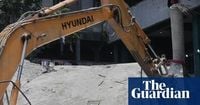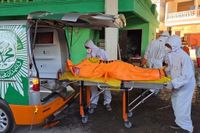The afternoon of September 29, 2025, was supposed to be like any other at the century-old Al Khoziny Islamic Boarding School in Sidoarjo, Indonesia. The air was thick with the anticipation of prayer, and more than 160 students—most of them boys between the ages of 12 and 19—were gathering in the prayer hall. But in a matter of moments, the ordinary turned catastrophic, as the school’s two-storey building collapsed, trapping scores of children beneath a mountain of concrete and debris.
According to Reuters, the collapse happened suddenly, with concrete walls and floors caving in on the students during afternoon prayers. Mohammad Fathulbari, a 14-year-old survivor, recalled, "During the Qur'an reading before the prayer, I noticed something falling from the ceiling. But I brushed it off, thinking maybe it wasn't concrete, just something else dropping." Moments later, the ground shook violently. "I looked up, then I just ran toward the front of the mosque where the imam was. Kids were crying everywhere, I couldn't see any way out, but some guys smashed through a wall and that's how we all got out."
Roughly 90 children managed to escape as the building began to give way, many suffering serious injuries as they scrambled over and under falling debris. The chaos was compounded by the darkness and confusion—students calling out for missing friends and relatives, some desperately searching for loved ones. Mohammad tried to find his cousin Rizal, but was pulled back by others for his own safety. "I kept insisting I had to find Rizal, but I was stopped and people dragged me back by the leg. I cried while searching, screaming his name, but he never answered," he told ABC News.
As the dust settled, the scale of the tragedy became clear. The National Search and Rescue Agency (BASARNAS) reported that 66 lives had been lost by the end of the first week, with the death toll climbing as more bodies and body parts were recovered from the rubble. The Associated Press noted that, as of October 6, 2025, 61 deaths had been confirmed, with two students still missing and no survivors expected. The grim work of recovery was made even more difficult by the condition of the bodies, many of which were unrecognizable. DNA samples were collected from grieving relatives at the Bhayangkara police hospital in Surabaya to aid in identification, and by that Monday, 17 bodies had been returned to their families for burial.
For the rescuers, the operation was a harrowing ordeal. BASARNAS described the collapsed building as a "pancake," with narrow, unstable spaces that made it nearly impossible to send in large teams. Emi Freezer from BASARNAS told ABC News, "We couldn't send in big teams. The level of difficulty was very high, and the working space was incredibly narrow, making it tough for rescuers." Rescue workers had to use hand tools to avoid causing further collapses. Nur Hadi Santoso, one of the rescuers, recalled, "A lot of the children were wedged in tiny voids, barely the size of my own body. We had to crawl in to pull them out, all the while tonnes of rubble sat right above us. The risk of a secondary collapse was about 99 percent, we hung onto that 1 percent chance it wouldn't give way."
Despite the dangers, there were moments of hope. Around 48 hours after the collapse, five children were rescued alive, spurring a surge of relief among the exhausted crews. "Thank God. The moment I saw the faces of those boys for the first time, all the fatigue just vanished. It was a real surge of energy," Santoso said. But as the days wore on, hope faded. By Thursday morning, October 9, 2025, no more signs of life were detected, and the operation shifted from rescue to recovery.
For the families, the wait was agonizing. From Monday night, relatives gathered near the school, sleeping on cardboard mats and tiled floors, clinging to hope for any news. Some families, like that of 16-year-old Mohammad Rizki Saputra, expressed their grief quietly. His aunt Ayuli told ABC News, "He's such a good boy, he's so handsome. Rizki is an obedient child, accepting, he never asks for anything. He likes to pray since he started at this boarding school. We're in such shock because he's such a good boy. We're not blaming anyone ... we're religious people and we believe we each have our own destiny." Many families echoed this sentiment, seeking comfort in their faith and the support of their community.
As the rescue and recovery efforts wound down, attention turned to the question of how such a disaster could have happened. The Associated Press and Reuters both reported that the building was undergoing an unauthorized expansion at the time of the collapse—a fact that has become central to the national debate about construction safety in Indonesia. According to structural engineering expert Mudji Irmawan of the Surabaya Institute of Technology, "Too often, people either ignore the national standard, or fail to use it as a reference during construction. There's been a lot of effort to promote and socialise these regulations, but many developers still see compliance as a burden. They think the standards make projects harder ... some building owners treat construction like it's easy work until something goes wrong. Only then do they realise why these codes exist in the first place."
Indonesia is home to an estimated 42,000 Islamic boarding schools, or pesantren, but only 50 reportedly have building permits, according to the country’s Public Works Minister, as cited by Reuters. It is unclear whether Al Khoziny had the necessary permits. The lack of oversight and regulation has now come under intense scrutiny, with Indonesia’s Religious Affairs Minister pledging to ensure that pesantren construction complies with safety standards in the future.
The tragedy at Al Khoziny has become a national wake-up call. As the Disaster Mitigation Agency described, this was the first time a building had collapsed without any external trigger like an earthquake, making it an "eye-opener" for the country. The agency concluded that a "technological failure in construction" was to blame, specifically the construction work on upper floors that the school’s foundations could not support.
For the survivors, families, and rescuers, the scars of the disaster will linger. But for Indonesia, the collapse of the Al Khoziny school is a stark reminder that safety standards are not mere bureaucratic hurdles—they are essential protections, and ignoring them can have devastating consequences. As Mudji Irmawan put it, "This incident should serve as a hard lesson for all of us. Personally, I was devastated. I cried when I saw the rubble of that collapsed building. As an engineer, I feel a deep responsibility for the outcomes of construction. The key message is this: we can't wait for more casualties before we act."


